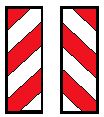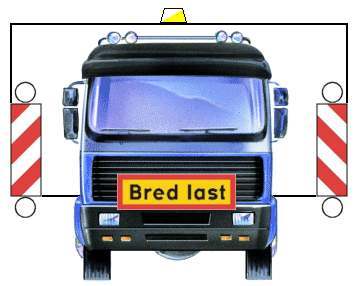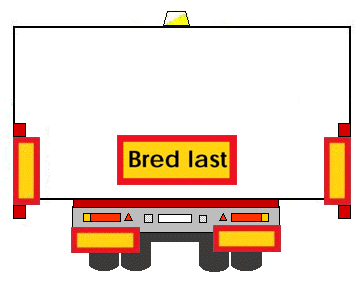Conditions - Transport exemption
In every exemption, the conditions that apply to that specific transport are indicated. Here we describe the conditions that apply in general.
Long transport
24 m – 30 m marking
Longer than 30 m but max 35 m marking, hazard warning vehicle, and steering axles
Longer than 35 m marking, hazard warning vehicle, escort, and steering axles
Wide transport
261 cm – 310 cm marking 311 cm – 450 cm marking and hazard warning vehicle Wider than 450 cm marking, hazard warning vehicle, and escort
Example of marking
Hazard warning sign for hazard warning vehicle

Hazard warning signs for transport vehicles




Front width markings

Rectangular reflective devices
![]()
On the back of the motor vehicle or load
![]()
On the back of the trailer or load
Transport vehicle
Hazard warning signs and width marking signs
Hazard warning signs must be affixed to the transport vehicle. The signs must be clearly visible from both the front and the rear. The forward-facing sign must be placed under the bottom edge of the windshield, with the bottom edge of the sign at most 2 metres above the roadway.

A width marking sign must be placed on each side of the vehicle. These must be place as close to the vehicle’s outer edge as possible, including the load, and so that they are clearly visible from the front.

There must be rectangular reflective devices on the rear of the vehicle. Laterally these must be placed as close to the vehicle’s outer edge as possible, including the load, and so that they are clearly visible from the rear. The load on connected vehicles must be marked like a trailer. The load on a traction engine must be marked like a vehicle.
Width marking signs and hazard warning signs must be illuminated during trips after dark, at dawn or at dusk, and otherwise when weather or other conditions require it.
Lamps
The outermost part of the vehicle, including load, must be marked in front with two lamps that shine a white light forwards, and with white reflectors. At the back, it must be marked with two lamps that shine a red light backwards, and with red reflectors.
The lamps must be set on the vehicle’s outer edge, including load. The lamps should be placed one above the other under the width marking sign or the rectangular sign (reflective device).
The transport vehicle must be equipped with at least one hazard warning lamp that gives off a blinking orange light. For trips in the daytime, the lamp must only be turned on when the transport encroaches on other traffic lanes. For trips after dark, the lamp must always be on if the transport is wider than 310 cm.
Hazard warning vehicle
The hazard warning vehicle must be a car or truck with a total weight of at most 4.5 tons. It must be equipped with hazard warning signs that are clearly visible from the front and the rear. The signs must be placed higher than the upper edge of the windshield.
The hazard warning vehicle must be equipped with at least one hazard warning lamp that gives off a blinking orange light. The light must be turned on for trips after dark. For trips during the daytime, the lamp must only be on when the transport encroaches on other traffic lanes.
There must be other radio connections besides a telephone between the hazard warning vehicle and the transport vehicle. Communication between the driver of the hazard warning vehicle and the driver of the transport vehicle must be carried out in a language that both parties understand.
The driver must have a class ‘B’ and ‘C’ licence. A hazard warning vehicle may follow at most three vehicles or vehicle combinations. No vehicle may be attached to the hazard warning vehicle.
Escort
For transports with a width over 450 cm, length over 35 m, and with a high gross weight we normally prescribe an escort by a traffic director or the police. A list of commissioned traffic directors is available on the Swedish Police website.
Heavy transport
For heavy transports, it is often stipulated that they must cross bridges in the centre with a reduced, constant speed, with no other vehicles on the bridge. If a bridge must be closed, this must always be done by a traffic director or the police.
Elevated transport (high transport)
It is always the responsibility of the transporter to make sure that the vehicle can reach its destination when the transport is taller than 450 cm.
Important to note
- An escort can be decided upon in other cases than those indicated above.
- Two hazard warning vehicles are required for transports that are simultaneously wider than 310 cm and longer than 30 m.
- A decision on a transport exemption is valid only under the condition that the requirements in the decision are followed.
Information on weight and dimension regulations can be found in the information brochure ”Legal loading”, which can be orderd och downloaded via the link at right.